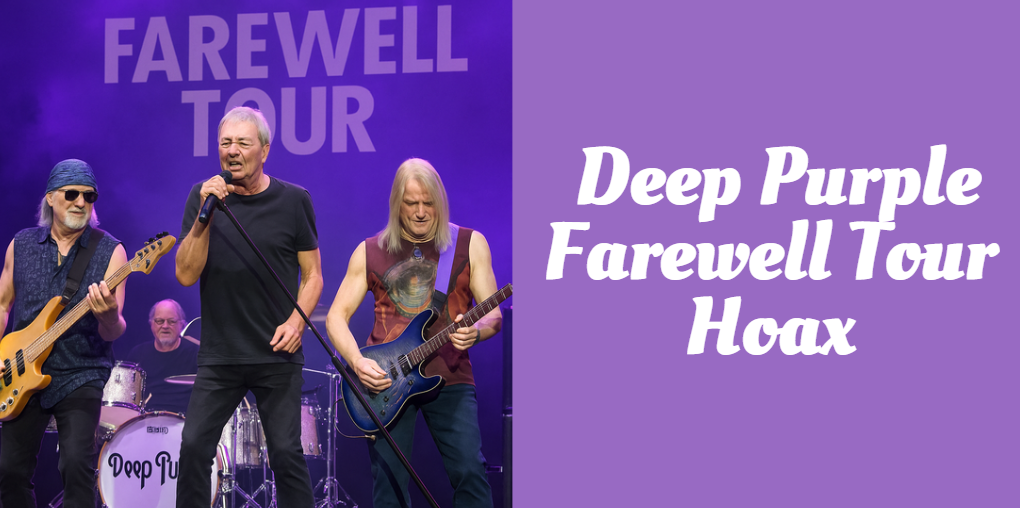The Truth Behind the Deep Purple Farewell Tour Hoax: A Deep Dive into Rock’s Most Misleading Goodbye
Deep Purple, one of rock music’s most influential bands, has etched an indelible legacy in the history of hard rock and heavy metal. Formed in 1968, the British band brought the world timeless classics like “Smoke on the Water” and “Highway Star.” With a career spanning decades, countless lineup changes, and millions of albums sold worldwide, Deep Purple remains a titan in the rock world.
In 2017, the band launched what was dubbed “The Long Goodbye Tour,” sparking widespread speculation that it was their final bow. Fans rushed to secure tickets, eager to witness what they believed would be the last chapter of Deep Purple’s storied career. But as the years rolled on and the band continued to perform, whispers of a “Deep Purple farewell tour hoax” began to grow louder.
This article unpacks the entire saga—from the origins of the tour to the surprising revelations made years later—offering fans and music lovers an in-depth look at how a supposed farewell turned into one of rock’s most debated tour stories.
The Long Goodbye Tour: Origins and Intentions
In late 2016, Deep Purple announced their upcoming 2017 tour under the name “The Long Goodbye.” The name alone suggested a slow, graceful exit from the global stage. Many interpreted it as a definitive farewell, prompting a surge of emotional responses and ticket sales.
According to the band’s initial statements, the name was chosen to reflect the possibility that it could be their last major tour. Given the members’ advancing ages and decades of touring, fans understood and respected the decision. The tour kicked off in May 2017 and spanned multiple continents, playing to packed stadiums and arenas.
The band never explicitly confirmed retirement but cleverly leaned into the ambiguity. This open-ended phrasing created both anticipation and urgency, driving attendance and media buzz. What no one realized at the time was that the term “long” would be the key to unraveling what some now refer to as the Deep Purple farewell tour hoax.
Behind the Scenes: The Reality of the Farewell Narrative
The real twist in this story came much later. In a 2024 interview, lead vocalist Ian Gillan broke the silence about the true intent behind “The Long Goodbye Tour.” He confessed that the tour name was largely a marketing strategy devised by promoters to boost ticket sales.
Gillan admitted that the idea was not his own, nor the band’s, but stemmed from external pressures. Promoters believed that labeling it as a possible farewell would generate more attention and revenue. In his words, “It wasn’t our idea. The promoters said, ‘We can sell more tickets if we call it a farewell tour.’”
What’s particularly interesting is how the band embraced the ambiguity. They added the word “long” to keep the interpretation vague and open-ended. It was never meant to be a definitive goodbye. This strategic ambiguity gave rise to the growing belief that the farewell tour was never meant to be final—hence the rising use of the term “Deep Purple farewell tour hoax.”
Fan Reactions and Public Perception
Fans around the globe responded with a mixture of emotions—relief, frustration, and even betrayal. Those who paid premium prices for tickets under the impression they were seeing the band for the last time expressed disappointment.
Common Fan Reactions:
| Reaction Type | Description |
|---|---|
| Sentimental Support | Many fans were happy just to see the band live again, regardless of the label. |
| Disappointment | Some felt misled and criticized the band’s lack of transparency. |
| Indifference | Others accepted it as a marketing tactic and focused on the music. |
Social media was ablaze with debates. Reddit threads, Facebook fan pages, and YouTube comment sections were filled with varying takes. Some argued that Deep Purple had every right to continue playing, while others felt the band exploited fan loyalty under false pretenses.
This reaction speaks volumes about the delicate relationship between artists and their audience, especially when commercial strategies come into play.
The Broader Trend: Farewell Tours in the Music Industry
The Deep Purple farewell tour hoax is not an isolated incident. Many legendary acts have famously retired—only to return again and again.
Examples of Farewell Tour Misfires:
- KISS – Their first “farewell” tour was in 2000, yet they’re still touring today.
- Cher – Has had multiple farewell tours spanning decades.
- Ozzy Osbourne – Announced a farewell several times, only to return with new albums and tours.
These examples reveal a wider trend where farewell tours are often more about marketing than actual goodbyes. While not inherently deceptive, these campaigns walk a fine line between celebration and manipulation.
In Deep Purple’s case, what separates their story is the later acknowledgment by a band member that the farewell aspect was indeed a “joke,” further fueling the hoax narrative.
Deep Purple’s Continued Activity Post-Tour
Despite “The Long Goodbye” beginning in 2017, Deep Purple remains active as of 2025. The band has not only continued to perform live but has also released new music, including their 2020 album Whoosh! and follow-up projects.
In an August 2024 interview, Ian Gillan further clarified the band’s intentions, stating they are booked through 2026 and have no plans to retire. This essentially confirms what fans had long suspected—that the farewell label was more of a promotional hook than a genuine declaration of retirement.
Recent Milestones:
| Year | Event |
|---|---|
| 2020 | Released Whoosh! album |
| 2022 | Performed major international festivals |
| 2024 | Ian Gillan confirms extended tour dates |
| 2025 | Continues live performances and interviews |
Ethical Implications and Industry Practices
The Deep Purple farewell tour hoax raises important ethical questions about honesty in the entertainment industry. While promotional tactics are common, misleading labels—especially those tied to emotional milestones like a farewell—can damage an artist’s legacy.
Critics argue that using retirement as a sales strategy exploits fan emotions. Fans often rearrange their lives, spend large sums, and travel far distances to witness what they believe is a final moment. When that moment is revealed to be merely a tactic, the trust can erode.
Yet others defend the practice, pointing out that bands have the right to change their minds. After all, art evolves, and so do artists. Still, transparency goes a long way in preserving fan loyalty.
Conclusion
The Deep Purple farewell tour hoax serves as a powerful case study on the intersection of music, marketing, and meaning. What began as a seemingly heartfelt goodbye turned out to be a calculated promotional campaign—one that delivered spectacular shows but left behind a trail of mixed emotions.
As Deep Purple continues to perform and evolve, the “Long Goodbye” becomes more of a clever branding move than a farewell. Whether fans feel tricked or simply grateful for more music, one thing is certain: Deep Purple’s impact on rock history remains untouched.
In the ever-shifting landscape of the music industry, the lesson here is clear—farewells are not always final, and not every goodbye means it’s the end.
Recommended Articles
Shaun Sampson ICExII: Redefining the Future of Tech, Fashion & Music
Inside the Creative Legacy of Susanne Capurso at 302 Spring Drive East Meadow
Omaha Seeya Wahyala: A Sacred Phrase of Vision, Spirit and Heritage
Aaron Gaun & InvestorLift: The Visionary Powering Real Estate’s Digital Revolution






